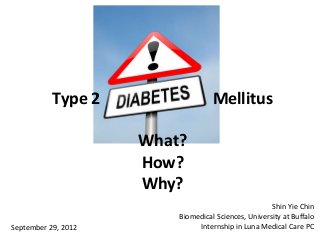
Shin yie type 2 diabetes mellitus
- 1. Type 2 Mellitus What? How? Why? Shin Yie Chin Biomedical Sciences, University at Buffalo September 29, 2012 Internship in Luna Medical Care PC
- 2. What is it? • Most common form of diabetes • 25.8 millions in the U.S. have diabetes (2011) • Body does not produce enough insulin OR • The cells ignore the insulin • Insulin: needed for the body to use glucose to produce energy
- 3. Eat Food Body breaks down all the HEALTHY sugars and INDIVIDUAL starch into GLUCOSE INSULIN GLUCOSE in takes cells GLUCOSE make from the ENERGY blood into cells
- 4. Eat Food Body breaks down all the DIABETIC sugars and INDIVIDUAL starch into GLUCOSE GLUCOSE in INSULIN blood takes HIGH BLOOD GLUCOSE SUGAR from the blood into cells
- 5. Diabetes Complications • Eye, foot, skin complications • Heart Disease • Mental health problems • Hearing Loss • Oral health problems • Nerve Damage • Kidney Disease • Stroke • Blindness • Amputation • Dehydration • ………..
- 6. Causes? • Lifestyle factors and Genetics • Obesity – runs in families, families tend to have similar eating and exercise habits • Bad eating habits, poor diet, not exercising • Genetics: runs in families, already in your gene, can’t change • Lifestyle: you can do something about it!
- 8. Risk Factors • Ethnicity: More common in African Americans, Latinos, Native Americans, Asian Americans, Native Hawaiians. • Age: risk begins to rise at about 45years old • Family history • Obesity / overweight • Inactive lifestyle • High alcohol intake • High fat and carbohydrate diet • High blood pressure
- 9. Symptoms • Frequent urination • Unusual thirst • Extreme hunger • Unusual weight loss • Extreme fatigue and irritability • Frequent infections • Blurred visions • Cuts/bruises that are slow to heal • Tingling/numbness in the hands/feet • Recurring skin, gum, or bladder infections
- 10. Myths • 1. Diabetes is not that serious of a disease. – Fact: Diabetes causes more deaths a year than breast cancer and AIDS combined. 2 out of 3 people with diabetes die from heart disease or stroke. • 2. If you are overweight or obese, you will eventually develop Type 2 Diabetes – Fact: Obesity is a risk factor, but other risk factors also play a role, such as family history, ethnicity and age. Many overweight people never develop type 2 diabetes.
- 11. Questions?
- 12. Thank you for your attention!
